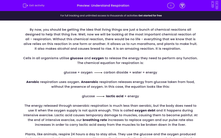By now, you should be getting the idea that living things are just a bunch of chemical reactions all designed to help that thing live. Well, now we will be looking at the most important chemical reaction of all - respiration. Without this chemical reaction, there would be no life - everything that we know that is alive relies on this reaction in one form or another. It allows us to run marathons, and plants to make fruit. It also makes alcohol and causes bread to rise. It is an amazing reaction. It is respiration.
Cells in all organisms utilise glucose and oxygen to release the energy they need to perform any function. The chemical equation for respiration is:
glucose + oxygen ![]() carbon dioxide + water + energy
carbon dioxide + water + energy
Aerobic respiration uses oxygen. Anaerobic respiration releases energy from glucose taken from food, without the presence of oxygen. In this case, the equation looks like this:
glucose ![]() lactic acid + energy
lactic acid + energy
The energy released through anaerobic respiration is much less than aerobic, but the body does need to use it when the oxygen supply is not quick enough. This is called oxygen debt and it happens during intensive exercise. Lactic acid causes temporary damage to muscles, causing them to become painful. At the end of intensive exercise, our breathing rate increases to replace oxygen and our pulse rate also increases in order to carry lactic acid away from the muscles to be broken down in the liver.
Plants, like animals, respire 24 hours a day to stay alive. They use the glucose and the oxygen produced during photosynthesis to release energy. The equation for respiration is the reverse of photosynthesis - look it up if you can't remember it and see if that's true!
Now let's move on to some questions.








